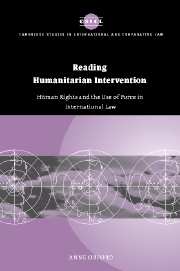Book contents
- Frontmatter
- Contents
- Preface
- 1 Watching East Timor
- 2 Misreading the texts of international law
- 3 Localizing the other: the imaginative geography of humanitarian intervention
- 4 Self-determination after intervention: the international community and post-conflict reconstruction
- 5 The constitution of the international community: colonial stereotypes and humanitarian narratives
- 6 Dreams of human rights
- Bibliography
- Index
- CAMBRIDGE STUDIES IN INTERNATIONAL AND COMPARATIVE LAW
2 - Misreading the texts of international law
Published online by Cambridge University Press: 05 July 2009
- Frontmatter
- Contents
- Preface
- 1 Watching East Timor
- 2 Misreading the texts of international law
- 3 Localizing the other: the imaginative geography of humanitarian intervention
- 4 Self-determination after intervention: the international community and post-conflict reconstruction
- 5 The constitution of the international community: colonial stereotypes and humanitarian narratives
- 6 Dreams of human rights
- Bibliography
- Index
- CAMBRIDGE STUDIES IN INTERNATIONAL AND COMPARATIVE LAW
Summary
When feminists deliberately and self-consciously read black letter law or critical legal scholars deliberately read judgments … in ways that such texts were generically and institutionally never meant to be read, they do it knowing that they are breaking the rules of the code, knowing that they are endeavouring to challenge those rules and to effect change by making the genres ‘mean’ differently (that is, making the genres tell a different story).
My aim in this chapter is to explain why I have chosen in this book to read legal texts about intervention ‘in ways that such texts were generically and institutionally never meant to be read’. The kind of productive misreading that I hope to develop here involves breaching some of the protocols that govern international legal scholarship, in order, as Threadgold suggests, to make these texts ‘“mean” differently’. Much legal writing in the field of intervention aims either at doctrinal exegesis, the description, development and refining of legal rules, or at studying the relationship between legal rules and the situations in which they take effect. My intention is to show that focusing only on the distinctions that legal texts make between a lawful and an unlawful intervention is to miss much of the most interesting work that those texts do.
- Type
- Chapter
- Information
- Reading Humanitarian InterventionHuman Rights and the Use of Force in International Law, pp. 38 - 81Publisher: Cambridge University PressPrint publication year: 2003



